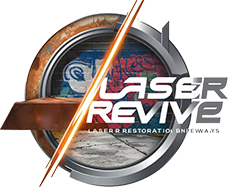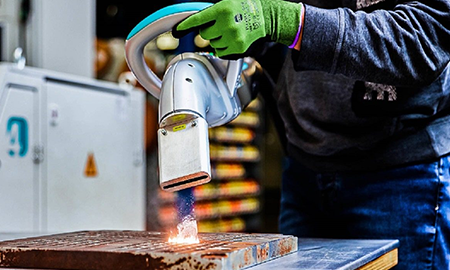Rust is the bane of many industries, from automotive to construction, and even in everyday household items. Traditional methods of rust removal, such as sandblasting or chemical treatments, often come with a host of problems including environmental hazards, health risks, and potential damage to the underlying material. Enter laser rust removal—a cutting-edge technology that promises to revolutionize the way we tackle corrosion. But what exactly is laser rust removal, and how does it work? Let’s dive in.
Understanding Laser Rust Removal
Laser rust removal is a non-contact, eco-friendly process that utilizes laser technology to remove rust, paint, and other contaminants from metal surfaces. Unlike traditional methods, laser cleaning is precise, controlled, and leaves the underlying material intact. This technique has gained popularity in various sectors due to its efficiency, safety, and environmental benefits.
How Does Laser Rust Removal Work?
At its core, laser rust removal involves directing a high-energy laser beam at the rust-covered surface. The laser’s energy is absorbed by the rust layer, which heats up rapidly and vaporizes or sublimates, effectively removing the rust without damaging the base metal. Here’s a step-by-step breakdown of the process:
1. Laser Generation:
The process begins with the generation of the laser beam. This is typically done using a fiber laser, which is known for its efficiency, stability, and high beam quality. The laser is generated within the laser source and then directed through optical fibers to the desired location.
2. Beam Delivery:
The laser beam is delivered to the surface via a handheld or automated laser cleaning head. This head can be adjusted for different angles and distances, allowing for precise targeting of the rusted areas. Advanced systems often come with integrated cameras or sensors to enhance accuracy.
3. Absorption and Heating:
When the laser beam strikes the rust layer, its energy is absorbed by the rust. Rust (iron oxide) has different thermal and optical properties compared to the underlying metal. This difference causes the rust to absorb the laser energy more effectively, leading to rapid heating.
4. Vaporization and Sublimation:
The absorbed energy causes the rust layer to heat up to the point where it either vaporizes (turns directly from solid to gas) or sublimates (turns from solid to gas without becoming liquid). This process effectively removes the rust layer without significant heating or damage to the underlying metal.
5. Residue Removal:
The vaporized rust particles are usually removed by an extraction system, ensuring a clean working environment. Some systems also include a secondary cleaning stage to remove any remaining particles or debris.
Advantages of Laser Rust Removal
Laser rust removal offers several advantages over traditional methods:
1. Precision:
Laser cleaning can be controlled with high precision, allowing for the selective removal of rust without affecting the surrounding areas. This is particularly useful for intricate parts or surfaces with delicate features.
2. Non-Abrasive:
Unlike sandblasting or grinding, laser rust removal is a non-abrasive process. This means it does not wear down or damage the base material, preserving the integrity and lifespan of the item being cleaned.
3. Eco-Friendly:
Laser rust removal eliminates the need for harmful chemicals and produces minimal waste. The process itself is clean and typically only requires electricity, making it an environmentally friendly alternative.
4. Safety:
Traditional rust removal methods often involve hazardous chemicals or produce dust and debris that can be harmful if inhaled. Laser rust removal is a safer alternative, with minimal health risks to operators.
5. Cost-Effective:
While the initial investment in laser equipment can be high, the long-term benefits and cost savings are substantial. Reduced labor costs, minimal maintenance, and the elimination of consumables (such as chemicals or abrasives) make it a cost-effective solution.
Applications of Laser Rust Removal
Laser rust removal has found applications in a wide range of industries:
1. Automotive:
In the automotive industry, laser cleaning is used to remove rust from car bodies, frames, and components. It’s also used in the restoration of classic cars, where preserving the original material is crucial.
2. Aerospace:
The aerospace industry benefits from laser rust removal in the maintenance and repair of aircraft components. The precision and non-damaging nature of the process make it ideal for high-value parts.
3. Manufacturing:
Manufacturing facilities use laser cleaning to prepare metal surfaces for welding, painting, or coating. The process ensures a clean, contaminant-free surface that improves adhesion and quality.
4. Cultural Heritage:
Conservators use laser technology to clean and restore historical artifacts and monuments. The ability to precisely control the cleaning process allows for the safe preservation of valuable items.
5. Marine:
Ships and offshore structures are prone to rust due to their exposure to harsh marine environments. Laser rust removal provides an efficient and eco-friendly method to maintain these assets.
Future of Laser Rust Removal
The future of laser rust removal looks promising, with ongoing advancements aimed at improving efficiency, affordability, and versatility. Innovations in laser technology, such as higher power lasers and more compact systems, are expected to make the process even more accessible and effective.
Research is also being conducted on integrating artificial intelligence and machine learning with laser systems. This could lead to fully automated rust removal solutions capable of adapting to different materials and conditions in real-time, further enhancing precision and efficiency.
Conclusion
Laser rust removal is a game-changing technology that offers a superior alternative to traditional rust removal methods. Its precision, non-abrasive nature, and environmental benefits make it an attractive option for a wide range of industries. As technology continues to evolve, we can expect laser rust removal to become even more efficient and widely adopted, helping us combat corrosion in a cleaner, safer, and more effective manner. Whether you’re dealing with rusty car parts, industrial machinery, or historical artifacts, laser rust removal is a powerful tool that ensures longevity and preservation without the drawbacks of traditional methods.

